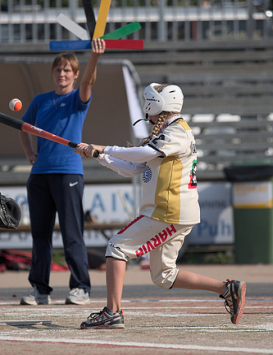By Nick Ubels (The Cascade) – Email
Date Posted: October 5, 2011
Print Edition: September 28, 2011
 Sucking in another breath of frigid autumn air, the batter approaches home plate. Bases loaded; two outs. She taps her bat against the sole of her cleated left shoe and slowly raises her gaze to match the pitcher’s.
Sucking in another breath of frigid autumn air, the batter approaches home plate. Bases loaded; two outs. She taps her bat against the sole of her cleated left shoe and slowly raises her gaze to match the pitcher’s.
The teams are wearing opposite colours of what vaguely resembles a NASCAR outfit. That is to say both the stylized jumpsuit masquerading as sports uniform aspect and the thick layer of ads coating it aspect reek of a stock car jockey’s attire. Everybody’s wearing a helmet. The pitcher glares back with a dead-eyed certainty. She is standing precisely eight feet away from the batter.
Blame it on the horrifyingly cold winters or the 100 per cent literacy rate, but the Finns don’t mess around when it comes to sports.
The small Scandinavian nation may only boast a population roughly one million stronger than the province of British Columbia, but your correspondent is willing to bet that his Canadian homeland would be thoroughly trounced by any of Finland’s Superpesis clubs.
Superpesis is the current incarnation of Finland’s most elite pesäpallo divisions for men and women. Its logo teeters on the brink of a copyright infringement suit from one of the big three American television networks that shall herein remain unnamed. Suffice it to say that if the peacock squeaks, it would not be surprising in the least.
Pesäpallo itself is colloquially known as pesis and the two terms are used interchangeably among most enthusiasts. Pesis is a hybrid of American baseball and traditional European ball and bat games. It’s also the national sport of Finland.
Former Finnish track and field star Lauri “Tahko” Pihkala is the pioneering sportsman responsible for refining this national past-time. With roots stretching back to the heady days of Finland’s newfound independence from Russia in the 1920s, pesäpallo is deeply entrenched in the nation’s sporting culture. It also has a lot of symbolic value. Presumably, this owes primarily to the fact of the appropriate socio-political climate surrounding its inception. While it is not quite as popular as ice hockey, at least 15,000 Finns took part in some league play in 2009.
You may be wondering how it works. Your correspondent imagines that delivering a thorough account of the rules of pesäpallo in fewer than 800 words would render the reader nearly as bewildered as the audience after the unforgettable scene in the Wes Anderson film Fantastic Mr. Fox where Owen Wilson’s Coach Skip explains the convoluted rules of Whackbat to the prodigiously athletic young fox Kristofferson. Without the benefit of a detailed, generously proportioned diagram, the feat is simply impossible. Therefore, the best way to proceed is to point out the major differences between Pesäpallo and baseball, its closest North American counterpart:
Difference #1: Vertical pitching
The most significant difference between baseball and pesäpallo is the start of play. In pesäpallo, the pitcher stands mere feet away from the batter. The pitcher then tosses the ball straight up at least three feet above the batter’s head and runs like hell to avoid receiving a bat to the face. This style of pitching opens up a tremendous variety of ways to hit the ball. According to the official website of pesäpallolito, the players’ union, vertical pitching allows for more, “speed and tactical dimensions than in baseball.” Interestingly, the batter can swing from either side of the plate and hit the ball fair up to three times before committing to run to first base. Which brings us to:
Difference #2: Zig-zag base placement
In pesäpallo, first base is located about halfway between where home and third would be in American baseball. From there, the runner must cross the width of the field to second. Third base is located directly behind first and rests twice as far away from home, following in a straight line. The possibility for collision between runners is somewhat staggering. Newcomers are advised to determine a directional lane system with their teammates before hitting the field.
Difference #3: Other assorted differences
Pinch hitters are called jokers. If a batter hits a triple, it counts as a home run. However, the player stays on third base and can score again as a regular runner.
All this makes for a somewhat chaotic defensive situation. The manager is left to call out plays on the fly in a knee-jerk response to however the batter decides to play the ball. Combine this unpredictability with offensive players criss-crossing each other mid-field and it becomes incredibly difficult to keep track of the play from an overhead perspective let alone the field itself.
In recent years, this national obsession and weirdly compelling twist on the old American past-time has become Finland’s chief recreational export. Small leagues have sprung up in Australia, Germany, Japan, and even Canada. So why not rediscover your old baseball gear and show a little Finnish pride?
Varten muisto Lauri Pihkala.


